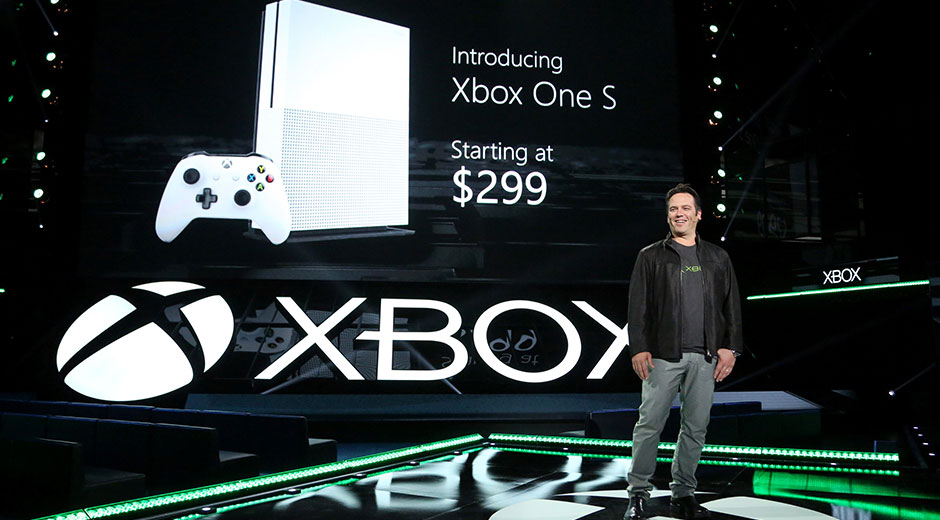Microsoft Teases 'Project Scorpio' Xbox Console For VR, But What Does That Mean?
To end the Xbox E3 event, Phil Spencer teased the company’s next project, a new console that would deliver “true 4K gaming and high-fidelity VR.” It’s coming in Holiday 2017, and it’s called (for now) Project Scorpio.
We don’t know too much about it yet, other than it will use an eight-core CPU with six teraflops of GPU power. When it comes out, you can use the same Xbox One and Xbox One S games and accessories to work with the Project Scorpio console.
According to Spencer, the reason for announcing Project Scorpio now was to give developers enough time to check it out and make games with the new hardware before it launches next year. More importantly, it’s a shot across the bow to the team at Sony and PlayStation, which are reportedly working on a new console, code-named “Neo,” which will support the 4K resolution as well as PlayStation VR.
If you're unclear on what exactly support for "VR" means here, you're not alone. There was no VR HMD announcement to go along with the Project Scorpio announcement, so it's not like this is a PSVR-style thing. However, there are some clues.
We spotted Todd Howard of Bethesda in the teaser reel saying that Project Scorpio could work with Fallout 4 VR, which means it would handle the Vive. A year ago, Microsoft demonstrated its marriage to the Oculus Rift by pledging that each would ship with an Xbox One controller and a wireless adapter for Windows. And we know that the Xbox One will essentially run Windows 10 as Microsoft creates it shared codebase for all devices.
Piecing together the above, perhaps Microsoft is making a hardware-agnostic play here. Maybe Project Scorpio will support both Vive and Rift (and OSVR HDK, for that matter), which would be a double coup. Not only would that allow an Xbox device to work with the HMD of your choice, it lets Microsoft avoid the trouble and expense of creating its own VR HMD.
Of course, Microsoft has the HoloLens, but that's a fundamentally different device than the Rift, Vive or OSVR HDK, and furthermore, the HoloLens is a completely self-contained mobile device.
Get Tom's Hardware's best news and in-depth reviews, straight to your inbox.
No, for Microsoft, an HMD-agnostic approach may be the best way to compete against the closed-system PSVR.
Follow Rexly Peñaflorida II @Heirdeux. Follow us @tomshardware, on Facebook and on Google+.
Rexly Peñaflorida is a freelance writer for Tom's Hardware covering topics such as computer hardware, video games, and general technology news.
-
sh4dow83 @Tomc100Reply
It's funny - I was recently assembling a mini PC (only on paper so far)... with integrated graphics, I'm up to 300$. Putting an RX480 into that, I'd be at $500. Right now, not next year. I'm thinking next year, the value drops to maybe $350.
Do you think MS will be able to match that price point? -
compote Project Scorpio is Xbox one S or a separate thing?Reply
Do people know what they're writing about all over the net? Why is nobody making it clear? Cos they probably don't know themselves? I've watched the conference and I still don't get it. -
turkey3_scratch Reply18116877 said:@Tomc100
It's funny - I was recently assembling a mini PC (only on paper so far)... with integrated graphics, I'm up to 300$. Putting an RX480 into that, I'd be at $500. Right now, not next year. I'm thinking next year, the value drops to maybe $350.
Do you think MS will be able to match that price point?
Let's not forget Microsoft gets to purchase hardware in bulk and for much cheaper. This is why an Xbox One or PS4 at their $300-$350 price point beats any PC in that price range, especially considering the cost of Windows. Many people say a cheap PC will beat the consoles for the cost, but no, it won't.
For instance, Xbox One costs $300. You get a $60 Xbox One controller with it for one thing. People who try to build computers to match or beat consoles for the same price never accomplish their goals and end up using things like really crappy power supplies. -
InvalidError So AMD finally decides to scrap the Redundant Numeral Rn-XXX prefix and decided to go with RX-nnn for their 14nm stuff. +1 for sanity check.Reply
Looking forward to seeing where the 460 and 470 will land performance and price wise. I'd like to upgrade my HD5770 this year but cannot be bothered to spend much over $150 to do so. -
turkey3_scratch Reply18117483 said:So AMD finally decides to scrap the Redundant Numeral Rn-XXX prefix and decided to go with RX-nnn for their 14nm stuff. +1 for sanity check.
Looking forward to seeing where the 460 and 470 will land performance and price wise. I'd like to upgrade my HD5770 this year but cannot be bothered to spend much over $150 to do so.
I think you intended to post this on a different thread ;) -
Martell1977 So AMD's "Zen" CPU will be in there, that's great for them. For the GPU, it does sound in line of the 480, meaning that the next console should have some impressive power and developers might actually push Intel into having more then 4core+HT in the consumer market.Reply -
InvalidError Reply
Seems like there was a news page layout issue when I opened the news page: no comment section directly below the RX-nnn report, which made it look like two things reported together.18117649 said:I think you intended to post this on a different thread ;)
